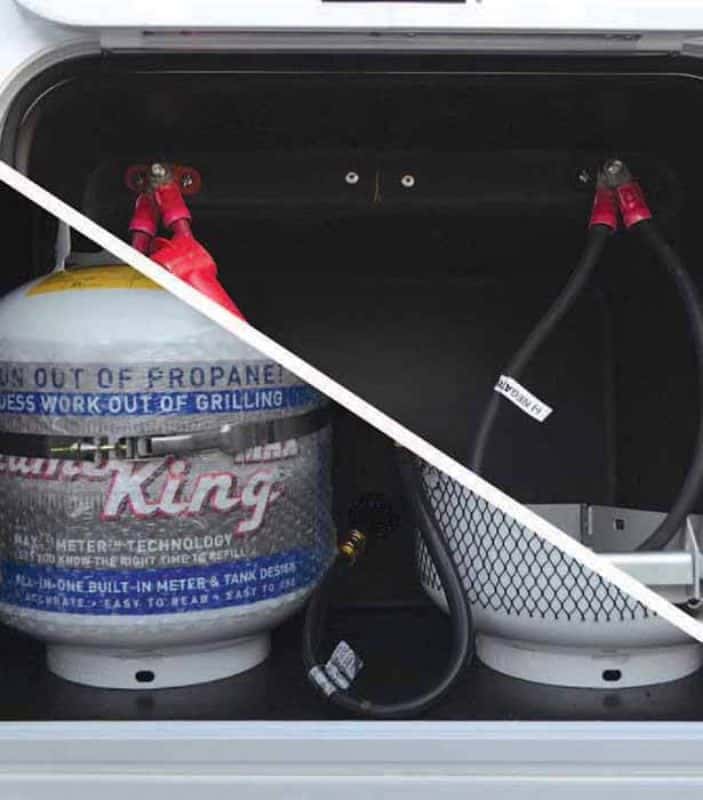Many RVs are opportunistically, euphemistically, or optimistically marketed as 4-season rigs.
(Which is a claim somewhere between wishful thinking and outright balderdash.)
If I go buy a Marmot 4-season mountaineering tent, now THAT’s a 4-season living space. A mountaineering tent is a double-wall engineering miracle made of 70D ripstop nylon. It costs as much as my car. It’s a portable shelter designed to withstand Arctic blizzards that could literally peel the skin off your face. -30 degrees and snowing? No problem!
But if I go buy a 4-season RV, I might (just might) be able to survive a mild winter in Virginia.
(Fair warning: I am rather passionate about this subject. It sets off my bullsh*t barometer.)
Why You (Might) Need an RV Polar Package
Don’t misunderstand me – I love the idea of a 4-season RV! A well-insulated RV isn’t just good for extreme cold. It’s good for any temperature above 90 or below 30.
Benefits of a 4-season RV package include:
- Reduced risk of frozen pipes.
- Reduced interior condensation.
- More powerful furnace
- Protected underbelly from corrosion and freezing
- Better resale value
- Higher initial construction quality
If you can get your hands on a good 4-season RV, do it. You won’t regret it. But that’s probably not why you’re here.
- You’re wondering whether paying for the $2,200 “Arctic Package” is really worth the money.
- Or you’re here because you spent the money, got the package, went camping, and woke up with a frostbitten nose.
So let’s get into what “4-season RV” really means.
The Real Truth About “4-Season” RV Design
You can buy many RVs with a “4-Season” package, also known as an Arctic, Blizzard, Glacier, or Polar package.
The salesman will promise you that you’ll be able to camp year-round, no matter what Mother Nature can dish out.
But here’s the real truth:
With a few exceptions, a “4-season RV” is really just “3.5-season.” Yes, they can survive freezing temperatures for short periods of time. But almost no RV is designed for year-round camping in sub-freezing temperatures.
Most Arctic, Polar, or 4-Season packages are bandaids, designed to just keep the water pipes from freezing. Don’t fool yourself into thinking that a 34-ft travel trailer with two slide-outs (read: drafty!) will ever survive a North Dakota winter.
For instance, here’s a video from Jayco touting the benefits of their ClimateShield design and testing:
Jayco tested their sample RVs at 0 degrees Fahrenheit for only 8 hours, people! That’s barely a good night’s worth of sleep!
- And there’s a big difference between testing 0 degrees with zero airflow versus 0 degrees in a blizzard!
- Plus, there’s also a big difference between maintaining a warm RV interior versus heating up a frozen RV that’s been outside in 15 degree weather!
- And how much propane did that furnace burn through, I wonder?
- Could the tanks have stayed unfrozen if the test had lasted, say, 72 hours, with only 5 gallons of water in the tanks?
Ach, maybe I’m just a cynic. I’m not trying to pin the tail on Jayco. I just think that if you sell a “4-season RV” to an unsuspecting customer, it shouldn’t come with a laundry list of fine print. Caveat emptor, indeed.
What’s USUALLY Covered in an RV Arctic Package

Say it with me: TANKS and PIPES.
4/5, that’s what an Arctic package covers. No more; no less.
RV manufacturers have a habit of listing everything under the sun on their Polar package brochures, whether it’s standard or not. I’ve seen water tank winterization bypass valves listed on “Arctic package” brochures – when virtually every single RV already has them! Ditto with sheet vinyl flooring. That’s already inside your camper!
So here’s what’s (usually) actually included in your 4-season package:
Tank heaters
4-season RVs usually have heated tanks, either using heated electric blankets, or by passing heated interior air around the tanks via furnace underfloor ducting.
There’s an obvious problem here. For RVs that rely on heated furnace air to warm your tanks, you have to run your furnace every few hours! If you try to save money by supplementing with a space heater, your tanks might freeze before the furnace kicks back on!
Heat tape and insulation
Any freshwater plumbing (normally PEX* or braided vinyl) NOT LOCATED in the camper body will have foam insulation and/or heat-tape.
Sealed underbelly
See my notes in the next section – a sealed underbelly is NOT the same thing as an undercoating! It just means the mechanical guts of your camper (tanks, LP manifold, etc.) are covered by underbelly material.
*Almost all modern RVs use PEX pipe for fresh water supply lines. PEX is naturally freezing-resistant (I said resistant, not proof!). It is semi-flexible and can expand somewhat without rupturing. A severe freeze (especially around a fitting) can still burst the pipe, though.
You’ll hear PEX marketing as “good down to -40 degrees!” That’s misdirection. The pipe plastic may not crack down to -40 degrees, but if enough ice forms at 32 degrees, the pipe will still burst!
You know what’s NOT on this list? Upgraded insulation. I tackled this topic in an earlier post, but most of the R-value claims about radiant foil insulation is just misdirection (or at least ignorance).
Stapling some bubble wrap with aluminum foil to your subfloor does not a 4-season RV make. To really stop the transfer of heat, you need thickness and air entrapment.
What MIGHT Be Included in an RV Arctic Package

Dual-pane windows
These windows, which can be made of either acrylic plastic or glass, are made like a sandwich with an argon gas core. Not only do they slow the transfer of heat; they also reduce interior condensation!
Insulated battery and/or LP compartments
With more and more RVers turning to lithium batteries, insulated battery compartments are becoming more important. You’ll find insulated battery compartments in Lance truck campers, for instance.
Heated storage bays
Some larger RVs, like motorhomes and 5th wheels, might duct heated air into basement cargo compartments.
Vent and/or window insulation pads
Some RV polar packages might include foam vent covers or window insulation pads. These are just squishy, rectangular foam pads that stuff into your roof fan holes to stop air drafts. Very useful! – but normally, you’ll have to buy them aftermarket.
Bigger furnaces
RVs don’t retain heat worth a darn. There’s no thermal mass, lots of drafty seals, and thermal bridges everywhere. So your RV manufacturer might upsize your propane furnace so it can run 24/7 during a hard freeze and keep you (and your pipes) warm inside! Or your RV might come with an electric fireplace or space heater, which you can use when plugged into shore power.
Attic vents
Temperature swings can drive water vapor into your RV “attic” (aka ceiling), where it condensates and causes mold. A good 4-season RV will have one or two attic vents to help dry out the ceiling.
What’s NOT Covered in an RV Arctic Package
Snow load
There’s zero guarantee your 4-season RV can withstand more than a few inches of snow on the roof.
Undercoating
Undercoating the belly of your RV to prevent corrosion from road salts is usually not included. Instead, you’ll likely get a sealed undercarriage, which is a fancy way of saying that your chassis and mechanical guts will be covered by Coroplast bellyboard and maybe stuffed with loose-fill fiberglass.
Extra structural insulation
It’s highly unlikely your walls, roof and floor are any thicker than the standard configuration. At most, you might have double-pane windows and some radiant floor insulation.*
*You will be tempted to ask about the RV’s insulation “R-value.” Unfortunately, as I explained in this expose post, almost any answer you receive will likely be junk.
Where to Buy a True 4-Season RV?
Here’s my Big Advice for shoppers looking for a true 4-season camper: Look outside of Indiana.
Look at manufacturers from the Pacific Northwest, Intermountain West, and Great Lakes region.
Here are some manufacturers you might want to consider:
- Lance
- Northwoods Manufacturing
- Oliver
- DRV Luxury Suites
- Outdoors RV
- Winnebago (Class B’s)



Certain designs are better-suited for 4-season RV living than others.
- Slide-outs tend to be draft and poorly insulated, with thin, lightweight walls.
- 5th wheels and motorhomes have better floor insulation thanks to the deep basements and chassis design.
- Smaller, cozier RVs are easier to regulate! Larger RVs can wind up with extreme temperature differences between rooms.
- You need a “walkable” roof to handle snow loads! Roofs with curved trusses shed water better than flat roofs.
It also seems that the larger the RV, the more difficult it is to find a true 4-season model. You can find a fair amount of 4-season truck campers, teardrop campers, and mini travel trailers.
If you’re buying a motorhome or 5th wheel, make sure it’s designed for full-time living, like something from DRV Luxury Suites or Luxe. Ask about the wall thickness and floor insulation. The thicker, the better (don’t forget to ask about the slide-out floor insulation!)
Lastly, remember this: A true 4-season camper is typically A) quite heavy and/or B) more expensive. Lightweight and cheap 4-season RVs simply do not exist. They are fairy tales. You’ll have more luck finding a Sasquatch pelt or photographing the Loch Ness Monster.
What’s Left Up to You

Hookups
You’re still in charge of your sewer drain line and freshwater supply hose. You’ll either need to purchase special heated ones (that plug in to campsite power), or insulate hoses yourself with pipe wrap or pool noodles.
Skirting
Skirting is your best defense against the cold (well, besides a puffy jacket and fuzzy slippers).
Extended storage
Unfortunately, all these nifty 4-season features only come into play when you’re camping. That means you can’t just turn off your RV, leave for two days, and come back. Your pipes and tanks will still freeze (albeit more slowly).
You have to A) leave your camper plugged in or B) leave the propane running while you’re gone.
Obviously, both of those solutions come with some hazards. If you’re not comfortable with leaving your RV unattended, then you’ll have to drain your water lines and tanks every time you’re gone longer than a day.
Tips for Camping in Frigid Weather
Lastly, I leave you with this:
Even if your RV didn’t come with Grade A+ design from the manufacturer, there’s a lot you can do to improve your cold-weather performance!
- Install skirting.
- Use a space heater.
- Insulate the windows.
- Control humidity.
- Good slippers.
I even compiled a compendium of cold-weather tips and tricks to help you stay warm inside your RV.
Stay toasty out there!
Leave a Reply